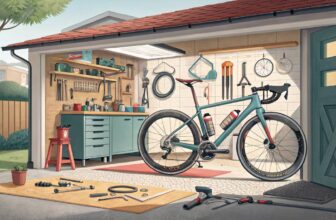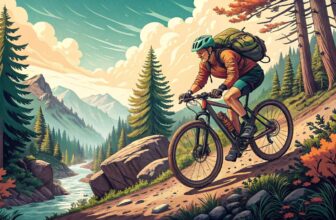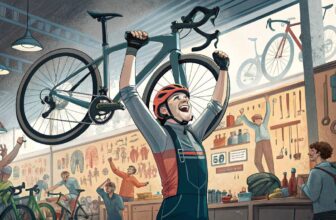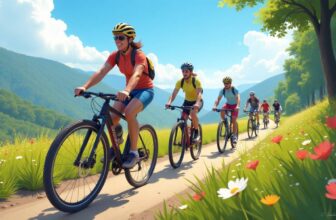Embarking on a new biking adventure? Test riding a bike isn’t just a trial run—it’s your first step toward countless memorable journeys.
Imagine cruising effortlessly down your favorite trail or navigating city streets with ease. Whether you’re a seasoned cyclist or a newbie gearing up for your first ride, mastering the art of a confident test ride can make all the difference.
Let’s dive into how you can breeze through the process, ensuring you find the perfect bike that matches your style and needs.
Preparing for Test Rides
Importance of Helmets
Helmets are the ride-or-die essentials for bikers, literally. They take the hit to save your noggin from nasty knocks. Falling off a bike can lead to serious head injuries, but helmets step up by sucking up the shock and keeping your brain intact.
Today’s helmets even go the extra mile with whiz-bang gadgets like built-in lights and reflective patches. A top-notch helmet ain’t just about safety; it’s about cruising with confidence and style.
| Feature | Benefit |
|---|---|
| Impact Absorption | Protects skull and brain |
| Built-in Lights | Makes you shine like a star |
| Reflective Elements | Keeps you seen in the dark |
Choosing the Right Time
Picking the perfect time for a test run is no small fry. You don’t want to be skidding on slick streets or squinting through the dusk. Smart folks who know a thing or two, like those at Chain Reaction, say aim for daylight rides, preferably when the roads are high and dry. Showing up an hour before the shop closes or before the sun’s tucked in could save you a bundle in hassle. Opting for the sunlit parts of the day means you’ll get to know if this bike’s your dream machine or just not your speed.
| Time of Day | Pros |
|---|---|
| Morning | Clear roads, sunny vibes |
| Midday | Bright as midday sun |
| Early Evening | Cool, calm, collected |
Nailing the prep work can flip a test ride from ‘meh’ to marvelous. Curious about dollars and the sense of buying a bike? Swing by our bike financing guide and bike purchase agreement.
Need a bit more hand-holding on when to snag the right ride or sizing up bike specs? Check out our when to buy bike and compare bike specs.
Bike Setup for Test Rides
Getting your bike ready is like prepping for a big date. Every tweak and turn makes a difference, especially if you’re bouncing between models—seat tweaks and tire checks are your ‘wingmen’ on this ride.
Seat Adjustments
A comfy seat is like finding the sweet spot on your sofa—the key to making sure your ride doesn’t turn into a bone-jarring experience. According to Chain Reaction Blogs, fine-tuning that seat could mean the difference between a joyful jaunt and a numb rear-end. A tilt here, a height change there, and suddenly, you’re in the bike sweet spot!
How to hit seat nirvana:
- Seat Height: Hop on the saddle with the pedal at its lowest point. Your leg should be almost but not completely straight—bend it just enough so you’re comfortable but powerful.
- Seat Tilt: Is it rocking back and forth or too forward? Flatten it out or make tiny adjustments up or down until your rump is smiling.
Need more help finding that perfect ride fit? Our bike size calculator might just be your new best friend.
Tire Pressure Checks
Tires are the shoes your bike wears and trust us, the right PSI makes all the difference. Get it wrong, and you’ll be feeling either like you’re dragging a rock or riding a pogo stick. Chain Reaction Blogs shows how even minor pressure tweaks can turn your ride into a marshmallow dream or a hardcore workout.
Here’s the tire-talk:
- Gauge It: Measure current pressure with a trusty gauge—less guessing, more precision.
- Sidewall Says: Check out the numbers printed on the tire’s side—follow this gospel.
- Pump it Up: Adjust using your pump until you hit that magic mark meant for your ride.
| Bike Type | PSI Range |
|---|---|
| Road | 80-130 |
| Mountain | 30-50 |
| Hybrid | 50-70 |
Dialing in the tire pressure makes testing feel like playing on a level field, so it’s no longer a battle of which bike cheats the best.
Prepping the bike properly lets you focus on the joy of the ride, and not whether you’re going to pop off the seat or spin out on tires. Makeup is ready for the ride of truth, and if you want more bike whispering tricks, take a peek at our used bike inspection and compare bike specs.
Key Factors to Check Out
Test rides are like speed-dating for bikes—it’s your chance to find “the one.” Here’s what you wanna look at to make sure you’re riding off into the sunset with the right bike:
Acceleration and Speed
Make your inner speed demon happy by seeing how the bike picks up and zooms along. Here’s the game plan:
- See how fast the bike hits the speed you’re aiming for.
- Notice if it keeps a steady pace on even ground and on those pesky hills.
Craving more juicy bike details? Check out our compare bike specs page.
| Bike Model | Acceleration (0-20 mph) | Average Speed on Flat Surface |
|---|---|---|
| Model A | 5 seconds | 18 mph |
| Model B | 6.5 seconds | 16 mph |
| Model C | 4.8 seconds | 19 mph |
Comfort and Handling
Feeling comfy and in control makes biking more like a joyride and less like a rodeo. Check these out:
- The bike’s feel when you hit bumps or rough patches.
- How nimble it is when you’re weaving through those corners and dodging obstacles.
- How well it tones down the bumpy ride on different surfaces.
Make sure you’re floating over roads, not battling them, and the bike doesn’t have you feeling like you’ve been on a bucking bull. For tips on getting the right bike fit, swing by our guide on bike frame sizing.
Terrain Versatility
Plan to be the conqueror of all surfaces? See what your bike’s up for:
- Roll it over pavement, gravel, and trail paths.
- Test it on the ups and downs of hills.
- Take it for a spin in both dry and soggy weather.
This will show if the bike is game for wherever your wheels wanna go. Dive deeper into this by checking our guide on bike terrain versatility.
Checking out these factors will help you sniff out the perfect bike match. Want to dive into more bike talk? Hit up our bike review research page for the full scoop on what’s hot and what’s not in the biking world.
Essential Safety Gear
Riding a bike isn’t just about pedal power; it’s about staying safe and having fun. So, let’s dig into the must-have gear that’ll keep you covered every time you spin those wheels.
The Importance of Helmets
Helmets ain’t an option—they’re a lifesaver. They cut down the chances of turning a harmless spill into a serious noggin knock. Fit’s everything. A wobbly helmet is no better than a hat, so rock it snug for total security. Curious about finding “the one” for your head? Check out our protective gear for biking for the lowdown.
Protective Gloves
Your hands take the brunt on the bars, so treat them right with some solid gloves. They help cushion the ride, keeping vibrations from giving you the jitters and cutting down on muscle strain. Plus, they’re your best pals against road rash in a tumble. With gloves for every season, your hands stay happy to come rain or shine. More insights? Here’s our guide on glove selection.
Reflectors and Lights
Be a beacon on two wheels. Getting seen is half the battle when the sun dips. Reflectors bounce back headlights, while bike lights brighten the path ahead. Having these in check makes night rides less like an eerie joyride and more like a lit-up parade. For a light-up-the-sky experience, peek at our article on bike lights and reflectors.
Protective Glasses
Your peepers need coverage too. Glasses don’t just make you look fly; they fend off wind tears, bugs, and glare. Look for pairs that won’t steam up when things get sweaty and keep the sun from making you squint. Dive deeper into eye safety in our protective glasses for cycling.
Having the right gear isn’t just about ticking boxes. It’s about zooming around with your peace of mind intact. Keen to know more about choosing your two-wheeled companion? Roll through our reads on bike frame sizing and new vs used bike. Get set, ride smart, and enjoy every pedal push!
Advanced Safety Accessories
Mirrors for Keeping an Eye Out
Mirrors are a must-have for cyclists, especially in cities where traffic’s like a game of Tetris. These tiny gadgets give you a peek at what’s happening behind you, letting you know when it’s safe to change lanes without twisting your neck like a worried owl.
Perks of Bike Mirrors
- Better Awareness: Mirrors help you spot cars and other hazards sneaking up on you, so you’re not caught off guard. This is super handy when you’re merging with traffic on your two-wheeler adventure.
- Simple to Use: Keeping tabs on traffic is a breeze with mirrors. First-time riders won’t need to master the awkward shoulder-check dance to know what’s going on behind them.
- Safety Boost in the City: Navigating through city traffic can be wild. Mirrors let you see what’s going on around you, so you can dodge surprises and keep yourself in one piece.
- Less Neck Pain: Forget cranking your neck all the time to check for cars. Mirrors make your rides way comfier, especially if you’ve got a long commute.
Different Kinds of Bike Mirrors
| Mirror Type | Description | Perfect For |
|---|---|---|
| Handlebar Mirrors | Clipped on the handlebars for easy adjustments and frequent use. | City rides and daily jaunts |
| Helmet Mirrors | Hooked onto your helmet, keeping in line with your head movements. | Road cyclists and folks who keep their heads on a swivel |
| Eyewear Mirrors | Mounted on your glasses for direct sight. | Long rides where constant checks are a must |
Choosing the right mirror depends on how you roll. Handlebar mirrors are great for city dwellers, while helmet and eyewear mirrors offer flexibility if you want a view that moves with you.
If you’re looking for more know-how on picking out the perfect bike, check out our articles on bike frame sizing, compare bike specs, and bike brands comparison. These reads will guide you to a bike and gear setup that’s just right for your riding style.
Conclusion
Finding the perfect bike is all about preparation, awareness, and understanding your personal riding style. From selecting the right helmet to fine-tuning your bike setup, every detail plays a crucial role in ensuring a smooth and enjoyable ride.
By choosing the optimal time for your test ride and paying attention to key factors like acceleration, comfort, and terrain versatility, you’re well on your way to making an informed decision.
Equip yourself with the essential gear and accessories, and you’ll not only ride with confidence but also elevate every biking experience. Happy riding!
FAQs
How long should a bike test ride be?
Aim for at least 20-30 minutes to thoroughly assess comfort, handling, and performance across different terrains.
What should I look for during a bike test ride?
Focus on fit and comfort, braking efficiency, gear shifting smoothness, handling, and how the bike responds to different terrains.
Do I need to bring my own helmet on a test ride?
Yes, bringing your own helmet ensures it fits properly and meets your safety standards.
How can I determine the right bike size for me?
A4: Use a bike size calculator based on your height and inseam, and ensure the bike feels comfortable during the test ride.
What accessories should I consider when test riding a bike?
Essential accessories include a helmet, gloves, lights, a bike lock, and a pump. Consider adding mirrors or a cycling computer based on your needs.




